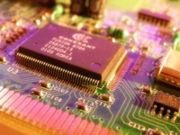Difference between revisions of "Machine intelligence/Intro"
From AdCiv
| (2 intermediate revisions by the same user not shown) | |||
| Line 1: | Line 1: | ||
| − | [[Image:ICpic.jpg|right| | + | [[Image:ICpic.jpg|right|180px|IC on PCB]] On the machine side, intelligence is increasing exponentially and should continue to do so for many years to come (see {{wp|Moore%27s_law|Moore's law}}). Not only are the total number of information processing units multiplying rapidly, but the relative computing power of each one is increasing exponentially too. |
On top of that algorithms and programming techniques are improving all the time to make more effective use of the hardware, as are {{wp|distributed_computing|distributed computing}} techniques which are able to make use of idle processor time between connected units. | On top of that algorithms and programming techniques are improving all the time to make more effective use of the hardware, as are {{wp|distributed_computing|distributed computing}} techniques which are able to make use of idle processor time between connected units. | ||
| − | The ever increasing sophistication and capability of computers mean that progressively more complex tasks can | + | The ever increasing sophistication and capability of computers mean that progressively more complex tasks can become automated. |
Latest revision as of 12:47, 18 July 2010
On the machine side, intelligence is increasing exponentially and should continue to do so for many years to come (see Moore's law ). Not only are the total number of information processing units multiplying rapidly, but the relative computing power of each one is increasing exponentially too.
). Not only are the total number of information processing units multiplying rapidly, but the relative computing power of each one is increasing exponentially too.
On top of that algorithms and programming techniques are improving all the time to make more effective use of the hardware, as are distributed computing  techniques which are able to make use of idle processor time between connected units.
techniques which are able to make use of idle processor time between connected units.
The ever increasing sophistication and capability of computers mean that progressively more complex tasks can become automated.
